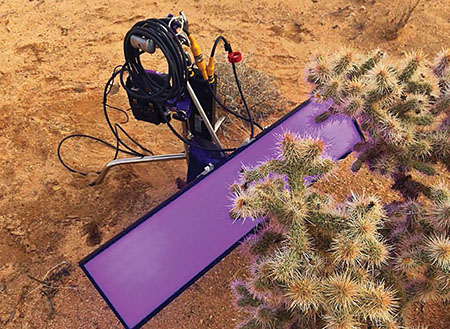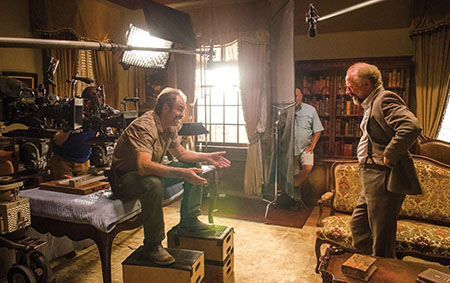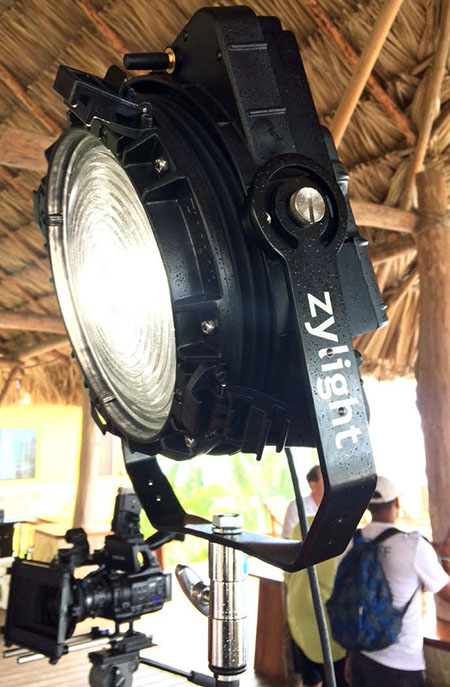Understanding Your Lighting Options
CHELMSFORD, U.K.—There’s a reason why century-old approaches to lighting are still in common use on film sets. A casual survey of the trade press over the last five years or so might easily give the impression that LEDs are the only game in town, but the reality is that there are at least four major artificial lighting technologies used every day on film sets around the world, plus a small selection of special- purpose tools. The cost of lighting rental is trivial to high-end productions, so there must be a reason why they’re not using LEDs exclusively, especially since LED fixtures so often elicit claims of high efficiency and enormous equivalent output power. Regardless of the reliability of those claims, knowing what works best, and in what way, lets us make better decisions about what to use, or even what to buy.

HDR shoot at Tasty Light Supply and ACME Stage in Minneapolis, using Kino Flo’s LED Select system.
PHOTO CREDIT: Matthew McIntosh
HALOGEN: CHEAP AND ATTRACTIVE
Nobody’s interested in using halogen incandescent lighting anymore, right? It’s inefficient, puts out a lot of heat, and if you want to match it to daylight, the required filtering eats up half the light. If you’re in a studio and paying studio fees for power, the cost will be a concern—particularly if you’re in a news studio, where you’ll be paying not only for the hot lights but also for the cold air to keep the on-air talent looking fresh.
It’s important to note that most of the filmmaking that actually happens in the world is not done in studios and doesn’t rely on generator power. If we’re less concerned about heat and power, tungsten lighting is an absolutely wonderful technology. It achieves about the best color rendering of any common light source; all but the smallest units are flicker-free to any frame rate you like; it can be dimmed smoothly all the way down to black; and the color shift that occurs when it’s dimmed is downright pleasant. There are few more attractive ways to light human skin than with a slightly dimmed tungsten lightbulb, and, of course, it’s cheap: 500W linear floodlights from a DIY store have essentially the same performance as upscale movie lights in terms of color quality and light per watt, though the movie lights are more controllable.
So let’s not overlook the old faithful. It’s affordable, effective, and so frequently used that it’s unlikely to cause any nasty surprises.

Steven Ogg as Simon and Xander Berkeley as Gregory on set of “The Walking Dead.”
PHOTO CREDIT: Gene Page/AMC
FLUORESCENT: LOW COST & EFFICIENT
If the benefit of LED lighting is the amount of light per watt, fluorescent deserves consideration because it achieves very similar results at an even lower cost. A 4-foot, four-tube Kino-Flo light system currently sells for just over $1,100 at B&H Photo Video and consumes something like 300W of power. We can get even more watts for even less money if we rely on the very cheapest LEDs, though these may have slightly suspicious color and build quality, but the point is this: a comparable ARRI SkyPanel S60-RP LED light, rated at one and a half times the power, costs nearly four times as much. Cheaper LEDs are available, but so are cheaper fluorescents.
Get the TV Tech Newsletter
The professional video industry's #1 source for news, trends and product and tech information. Sign up below.
Both, incidentally, can be run off of battery power. Lots of LEDs are made to run from batteries, and even big ones like the SkyPanel will do it, given a sufficiently upscale battery; Cine Power International makes one dedicated to the task. Given a battery-powered ballast or a simple inverter, however, fluorescents can do the same trick. A watt is a watt, and fluorescent can give us a similar amount of light per pound of battery carried by a perspiring crew member.
There are downsides. Fluorescent can’t be dimmed, at least not much, and not without an unpleasant color shift toward purple. The SkyPanel ‘C’ offers color mixing, but at some penalty to output and color quality. If you need dimming, fluorescent isn’t the tool for you.
LEDs can provide hard light from a small source, which is another thing fluorescents can’t do. If you want soft light, though, a fluorescent produces that out of the box, and at a rather lower cost than comparable LED fixtures.
HMI: MAXIMUM POWER
Like fluorescent, HMI has roughly the same efficiency as LED. The big difference is in the power level: the very smallest HMIs, at a few hundred watts, are about as powerful as the most powerful common LEDs. There are bigger LEDs, such as Mole-Richardson’s Tener LED, which, at 1600W, is probably among the most powerful single-lens LED lights available. Still, at around $10,000, it’s more or less the same price per watt as an ARRI True Blue D25 HMI, which is probably more powerful. The most powerful single-lens movie lights in existence are HMIs, at up to 24kW each. These are the tools of high-end shoots, of course, but no LED comes anywhere near that level of power.
It’s a similar story at levels more suitable for wall socket power. There is still nothing that compares to the 1200W HMI. Though it’s true that LED is racing to catch up, it’ll be a few years before there are replacements for the common 1200W and 2500W HMIs. Again, HMI is not dimmable, though there are now HMI bulbs that emit tungsten as well as daylight color temperatures.
The biggest obstacle to HMI use is that the minimum investment can be quite large. LEDs seem cheaper, and easier to power, simply because they don’t achieve the high power levels of HMI. Cost per watt can tell a different story.

Harry Frith used the Zylight F8-200 and Aladdin BI-FLEX 2 on location for HGTV when an outdoor shoot was forced to move under shelter because of bad weather.
LED: LOW POWER, BRIGHT COLOR
LED is the unquestioned king of low-power-level lighting. In reality, it’s no harder to battery-power a 200W HMI or 200W fluorescent than a 200W LED, but it’s become much more common to engineer LEDs for battery-powered operation. Another application in which LEDs really shine is when there’s a need for colored light, either for effects or for illuminating a chromakey screen. White LEDs may barely be pushing ahead of fluorescent and HMI in sheer luminous efficacy, but if we want bright red light, it’s much more efficient to use red-emitting LEDs than to create white light and filter two-thirds of it out. The ability to mix LED colors on the spot makes it possible to match practical lighting by eye, without requiring a truck full of gels.
In the pro column, LED is the only lighting technology available that dims without color shift. (Most LEDs do shift very slightly over temperature changes, but the change is microscopically slight.) In the con column, LEDs don’t often dim smoothly all the way to black because of technical limitations in the drive electronics. Some, such as Photon Beard’s Highlight LED series, achieve a smooth fade-to-black using pulse width modulation. This solution raises a very minor issue with shooting high frame rates when using the very bottommost part of the dimming range, though other lights would simply cut abruptly to black at that point anyway. Other LEDs, such as Outsight’s Creamsource range, offer clever features such as flicker simulation and even synchronized strobe effects to avoid flash banding on rolling shutter cameras. LED is the only mainstream lighting technology that can switch fast enough to pull off these effects.
There will always be situations (big backlights on night exteriors, filling shadows during the day) that require more power than LED can muster, though research and development will eventually solve the power problem. At the time of this writing, the very latest generation was pushing toward 500W, with a clear demand for more. Possibly all lighting will effectively be LED-based one day.
Phil Rhodes is a cinematographer, technologist, writer, and, above all, communicator. He can be reached atphil_rhodes@rocketmail.com.
